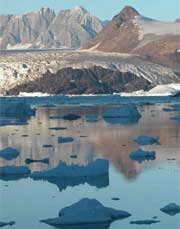 |
Some areas in Greenland have almost no ice left on the ground. (Photo: Nature) |
The glaciers on Greenland, which have been slowly drifting into the sea since the last Ice Age, have begun to accelerate. Some rivers are now flowing into the sea at a rate of 14 kilometers per year.
The entire ice mass on the island is losing 220 cubic kilometers each year due to calving and melting, according to research by Eric Rignot from the California Institute of Technology in Pasadena and Pannir Kanagaratnam from the University of Kansas in Lawrence. This figure is double what it was a decade ago.
Most of the ice caps on this continent have thinned over time. Although the central part of the island is thickening, it does not compensate for the loss. Rignot emphasized.
The melting of ice from Greenland has contributed to a sea level rise of 0.5 millimeters, more than double last year’s prediction. These figures are demonstrating how climate change is impacting the environment. However, Rignot also noted that not the entire continent is turning into water.
T. An




















































